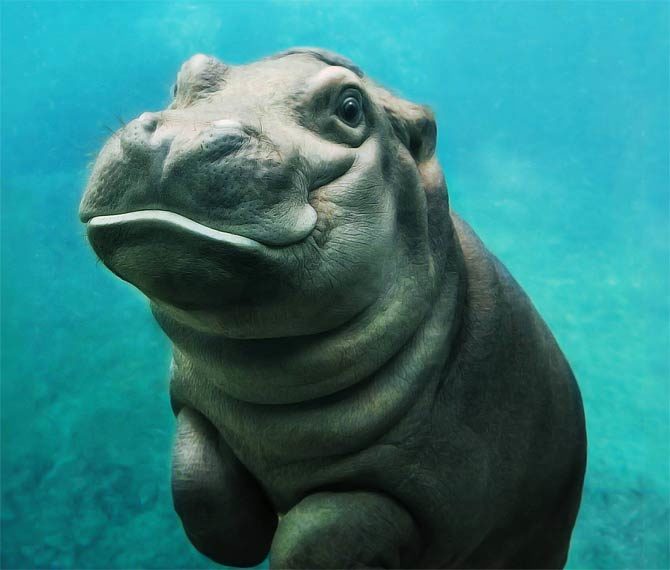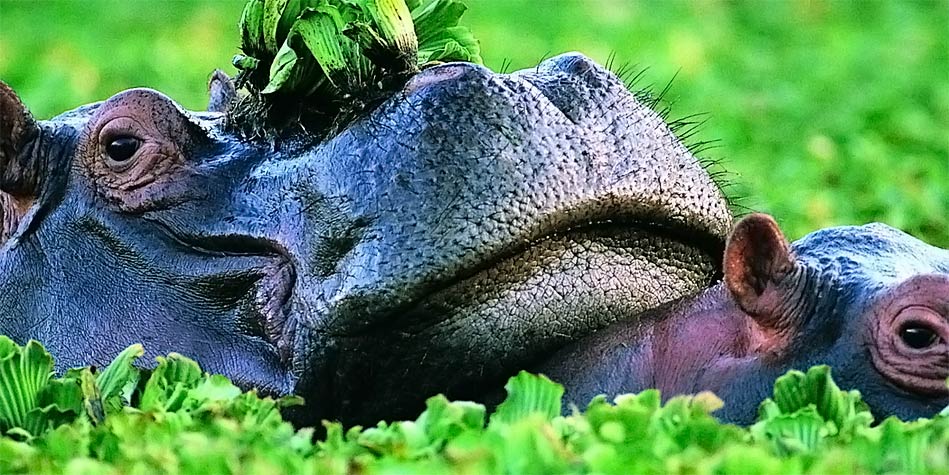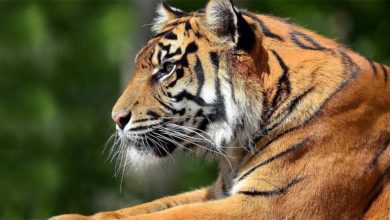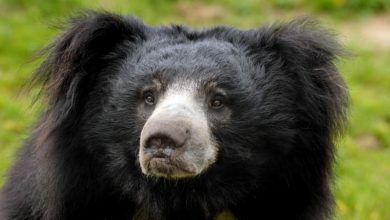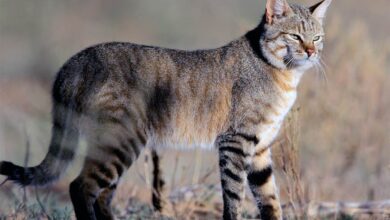The hippopotamus, hippo
The name hippopotamus comes from the Greek language, where the individual components mean: ‘ιπποπότόμος (hippopotamos, hippos -‘ horse ‘, potamos -‘ river ‘). Hippopotamuses are large ungulates mammals.
The hippo is the third largest terrestrial animal in the world. Only the elephant and the white rhinoceros are ahead of him. The full classification – look at the table: The biggest animals in the world.
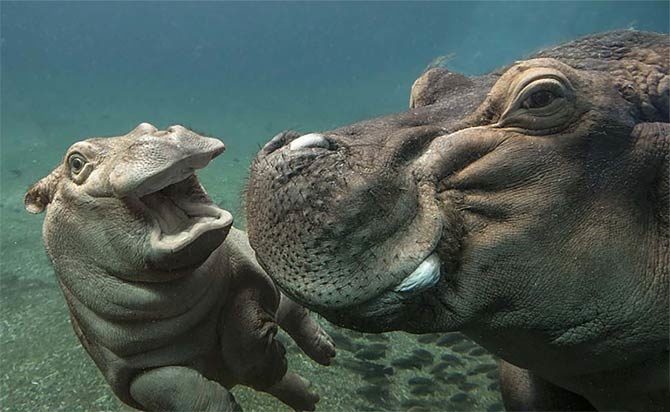
Within the Hippopotamidae family, we currently distinguish two contemporary living species:
Common hippopotamus (Hippopotamus amphibius)
- Angola hippopotamus H. a. constrictus – in Angola, the southern Democratic Republic of Congo and Namibia, named for its deeper preorbital constriction
- Cape hippopotamus or South African hippopotamus H. a. capensis – from Zambia to South Africa, most flattened skull of the subspecies
- East African hippopotamus H. a. kiboko – in Kenya in the African Great Lakes region, and in Somalia in the Horn of Africa. Broader nasals and more hollowed interorbital region
- Great northern hippopotamus or Nile hippopotamus H. a. amphibius – (the nominate subspecies) which stretched from Egypt, where they are now extinct, south up the Nile River to Tanzania and Mozambique
- West African hippopotamus or Tchad hippopotamus H. a. tschadensis – throughout Western Africa to, as the name suggests, Chad, slightly shorter and wider face, with prominent orbits
and a much smaller one:
Pygmy hippopotamus (Choeropsis liberienis / Hexaprotodon liberiensis)
- C. l. liberiensis
- C. l. heslopi
Occurrence
The hippo lives in the middle and southern Africa, mainly on the river and lake shores. It always stays close to water. Such baths help it avoid overheating its huge body and protect the skin against insects.
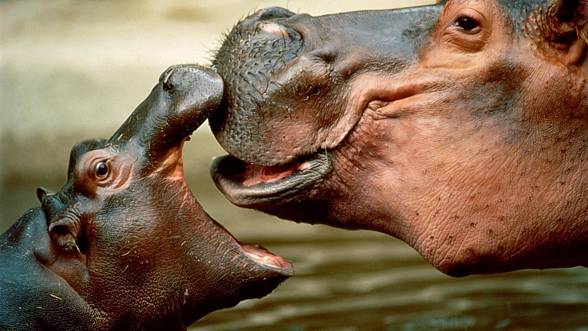
Diet
Although hippos are water animals, most of their food are land plants. At night, when the air temperature falls down, they go ashore in order to eat grass. Although hippos are very good swimmers, they prefer staying in shallow nearshore paddling pools or bays with stagnant shallow water. Then, they splash lazily emitting satisfaction rumbles.
Although the hippo has fatty tissue and prominent belly, it is very nimble. When the lion attacks the hippo during wandering on the land, the hippo can protect itself almost every time. The hippo’s massive built causes that the attack can result in the predator’s death.
The pygmy hippopotamus ( Choeropsis liberiensis)
The pygmy hippopotamus is much smaller than its relative, the common hippopotamus. Its weight is not more than 300 kg. It lives in equatorial rainforests in Liberia and Ivory Coast. Similarly, to its bigger relative, it stays near rivers and lakes. It eats mainly rhizomes and plant roots. These days, unfortunately, this species is endangered. In Poland, the pygmy hippo lives in the zoo in Wroclaw and it is successfully reproduced. In 2012, a small pygmy hippo was born.

Detailed information:
The common hippopotamus (Hippopotamus amphibious)
- length: 330-520 cm
- the length of the tail: around 56 cm
- height: 150-165 cm
- weight: adults: 1500-1800 kg, older species even up to: 3200-3600 kg (the record is 4500 kg)
- the length of teeth up to 30 cm ( the Tyrannosaurus had the same length of teeth)
- the weight of head: up to 225 kg
- sexual maturity: females 5-6 years, males 7-8 years
- pregnancy: 8 months
- the number of young: usually 1
- lifetime: 40-50 years (the record is 61 years)
- the speed of the run: up to 50 km/h (short distances)
- the speed in water: up to 8 km/h
- the thickness of the skin is 4 cm, it is 25 % of the body weight
- the small hippo weighs 25-45 kg after the birth and is approximately 125 cm long
Males of the common hippo grow through their lifetime; females reach the maximum size at the age of 25 years old.
The pygmy hippopotamus (Choerpsis liberiensis / Hexaprotodon liberiensis)
- length: 150-177 cm
- height: 75-85 cm
- the length of the tail: around 20-25 cm
- weight: 180-275 kg
- the sexual maturity: 4-5 years
- pregnancy: 190-210 days
- the number of the young: usually 1
- a small hippo weighs 4.5-6.2 kg after the birth
- lifetime: 30- 50 years
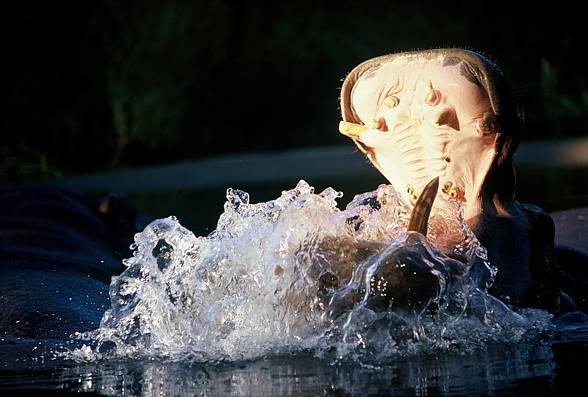
Hippopotamuses show the aware upbringing that is rarely encountered among animals. When the young behaves properly, its mother licks it with tenderness whereas when it is disobedient, the mother heats it with its head.
Eyes, ears and hippo’s nose are situated at the top of the animal’s head. Thanks to it, the animal can stand or sit being almost totally covered with water. Hippos can travel inland up to 8 km in order to look for food.
Although hippos are physically similar to pigs and other even-toed ungulates, their closest relatives are cetaceans, whales, porpoises and dolphins.
The common ancestor of whales and hippos separated from other even-toed ungulates about 60 million years ago. The oldest known hippo’s fossils from Kenyapotamus species are 16 million years old – they were discovered in Africa.
Hippos live in herds, which consist of the dominating male and subordinated females. The herd is usually from 10 to 40 species. Males protect its territory, which encompasses the part of the river where the herd gathers.
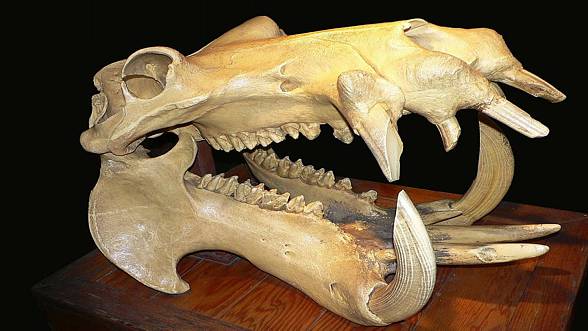
Hippos fight with each other to protect their territory and to be the leader of the group. Because of them, hippos have serious injuries caused by 30-centimeter long teeth.
The common hippopotamus population is estimated between 125-150 thousand species at wild.
Why do hippos yawn?
Although the hippopotamus gives the impression of an animal that often yawns, its “yawning”, in which he reveals his 30 cm teeth, is more a way to express a threat than the effect of being bored.
Aggressive hippos
Hippopotamuses are commonly believed to be dangerous and show aggression both for the representatives of the same species (males’ fights) as well as crocodiles, other animals and people. It is very popular that hippos attack boats, which are described by Michael Crichton in his book ‘Congo’. One can find the picture on the Internet, which says that hippos kill 2900 people every year.
To tell you the truth, we have not been able to confirm these statistics. According to our knowledge, there is no credible statistics proving that hippopotamuses kill people. However, it is commonly believed that there are such cases – especially when there are people on boats. The hippopotamus attacks happen despite the lack of goading them.
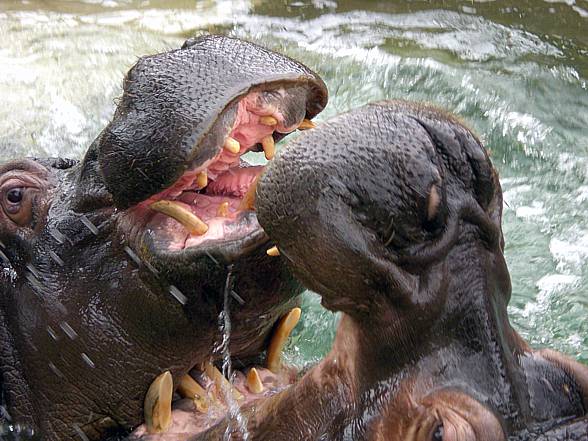
The hippopotamus – curiosities. Do you know that:
- Males of the common hippopotamus increase its weight throughout their lifetime.
- Females reach the maximum weight at the age of around 25 years.
- Adult hippos do not have the displaced body.
- Hippos move by jumping in deep water pushing oneself from the bottom.
- Hippos used to exist in Europe too.
- The young hippo weighs around 25-45 kg after the birth.
- The adult hippo eats about 30-40 kg of food every day.
